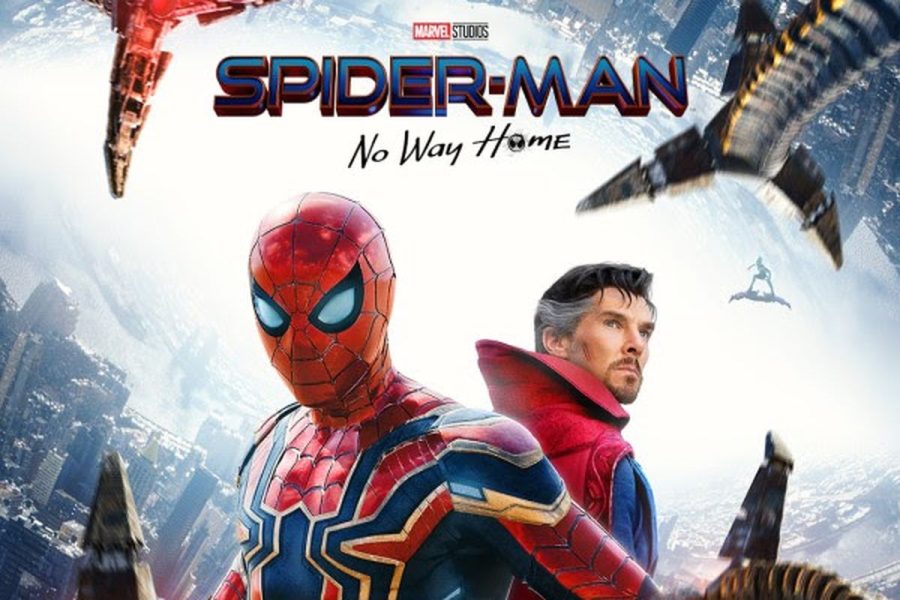Three generations, four new movies
‘No Way Home’ provides nostalgia, expands more than the multiverse
Promotional poster for “Spider-man: No Way Home.” With the introduction of former Spider-men and their original villains, as well as a teaser for the next few Marvel movies, Marvel uses the past to establish a lengthy future for its cinematic multiverse.
Spoiler alert: This analysis reveals details that may lessen a first-time viewer’s experience.
As three generations of Spider-men walked onto the screen, it was as if three generations of people came together in one moment to share something they all had in common, their friendly neighborhood Spider-man.
For most viewers, it was like reliving their childhood all over again, whether they grew up watching Tobey Maguire or admiring Andrew Garfield. Seeing each Spider-man work together to stop the villains from their own movies, was surreal for anyone looking forward to a generational partnership between all three Spider-men.
Watching “Spider-man: No Way Home,” it’s easy to say that Marvel, who tend to specialize in crossovers, has outdone themselves. Instead of bringing in characters from other Marvel movies, it brought in three generations of villains and Spider-men. When each Spider-man entered the film, the audience went wild, signifying its approval with cheers and applause.
The whole reason why the original Spider-men and their villains are in the Marvel Cinematic Universe goes back to “Spider-man: Far From Home.” In the end of “Far From Home,” Mysterio, played by Jake Gyllenhall, reveals Spider-man’s identity as Peter Parker, and frames Spider-man for his murder.
Continuing to “No Way Home,” Peter Parker finds Doctor Strange, played by Benedict Cumberbatch, and asks him to make everyone forget that Peter Parker is Spider-man. That’s when things go wrong.
Doctor Strange cracks open the multiverse just wide enough to bring back everyone who knew Spider-man, including anyone from past Spider-men series. Throughout the entire movie, Tom Holland’s Spider-man rounds up each villain and tries to help them live normal lives.
But once they all get loose again, Tom Holland’s Spider-man is on a mission to save the villains with the help of both Tobey Maguire and Andrew Garfield’s Spider-men. After a successful rehabilitation of the villains, everyone is sent back to their original universe and Tom Holland’s Spider-man has chosen to sacrifice everything, including everyone’s memory of him, to repair the multiverse.
While everyone has left, and it seems as though Strange has fixed the multiverse (at least in that moment), “Spider-man: No Way Home” does not necessarily fix all the problems of the multiverse and answer all of the fans’ questions. Instead, it sets up four new movies in Marvel’s future.
As its second end-credits scene, “Spider-man: No Way Home,” introduced the first teaser trailer for “Doctor Strange in the Multiverse of Madness.” With Strange meeting up with Wanda and introducing comic character America Chavez, as well as a new “Dark Doctor Strange” previously introduced in Marvel’s “What if…?” series, Marvel once again demonstrates how to keep an audience in anticipation.
As the multiverse expands, so do the actors’ abilities to play their characters. Once Willem Dafoe’s Green Goblin gets loose and, after a long battle with Spider-man, Aunt May dies in the crossfire, Tom Holland’s expression of grief and sadness is enough to move an entire audience.
The anguish and pain seen from Tom Holland can only be contained by Tobey Maguire’s Spider-man, stopping Tom Holland from avenging his Aunt May’s death.
Spider-man producer Amy Pascal has confirmed that Tom Holland will return for another three movies of his own. Some fans speculate that the movies will take place as a college trilogy for Peter Parker as he graduates high school.
“Spider-man: No Way Home,” continues Marvel’s tradition of crossovers and recent introduction of the multiverse. With the reveal of past Spider-men and expansion of the multiverse, Marvel has outdone themselves using the past to further develop the phase four storyline.


